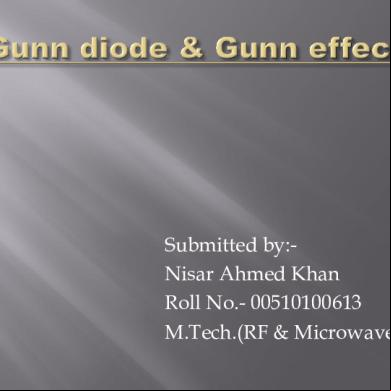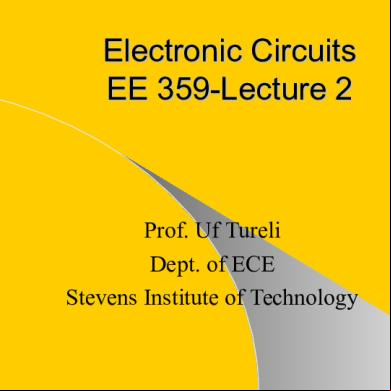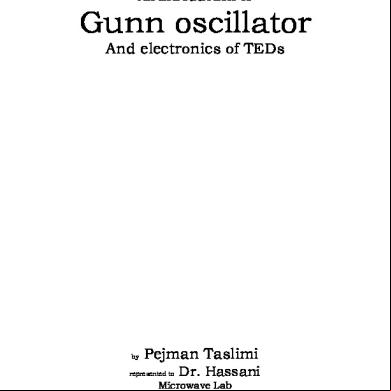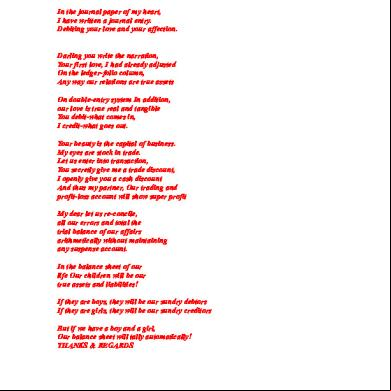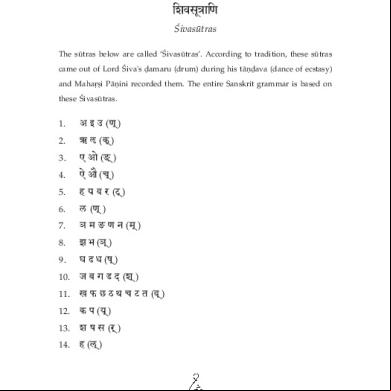Gunn Diode 3px1x
This document was ed by and they confirmed that they have the permission to share it. If you are author or own the copyright of this book, please report to us by using this report form. Report 3b7i
Overview 3e4r5l
& View Gunn Diode as PDF for free.
More details w3441
- Words: 1,623
- Pages: 40
Submitted by:Nisar Ahmed Khan Roll No.- 00510100613 M.Tech.(RF & Microwave Engg.)
Contents •
Overview of The Gunn Diode
•
Gunn Effect
•
Two-Valley Model Theory
•
Gunn-Oscillation
•
Gunn Oscillation Modes
Overview of The Gunn Diode What is it? • semiconductor device which have only N type doped (semiconductor) material. •
•
The Gunn diode is used as local oscillator covering the microwave frequency range of 1 to 100GHz
Gunn Diode is also known as: Transferred Electron Device (TED). Microwave Semiconductor Device
How it works?
By means of the transferred electron mechanism, it has the negative resistance characteristic
Gunn
Diode
was
invented
by
physicist,John
Battiscombe Gunn, in 1963, in IBM. Transferred Electron Effect was first published by:
Ridley and Watkins in 1961.Further work by Hilsum in 1962,
Finally
J.B.
Gunn,
semiconductor, in 1963.
observed
it,
using
GaAs
In a negative resistance the current and voltage are out of phase by 180. The voltage drop across a negative resistance is negative and a power of -I2R is generated by the power supply. i.e positive resistance absorbs power (ive devices) and negative resistances generates power (active devices).
•
GaAs (Galliam Arsenide ) has a property of negative resistance.
•
The negative resistance in Gunn diode is due to
(a) electron transfer to a less mobile energy level How electron move into low mobility ? According to Einstien Equation E=mc2 (b) high reverse bias (c) electron domain formation at the junction
Transistors operate with either junctions or gates but TEDs are bulk devices having no junctions or gates. The majority of transistors are fabricated from Si or Ge whereas TEDs are fabricated from GaAs, InP or CdTe.
Transistors operate with “warm” electrons whose energy is not much greater than the thermal energy of the electrons in the semiconductors whereas TEDs operate with “hot” electrons whose energy is very much greater than the thermal energy. Because of these fundamental differences, the theory and technology of transistors cannot be applied to TEDs
Construction:
Gunn diodes are fabricated from a single piece of n-type semiconductor, Source Material: Tri-methylgallium and arsenic (10% in H2). Most Common Materials : Gallium Arsenide (GaAs) and Indium Phosphide (InP).
Gunn Effect •
Gunn effect was discovered by J.B Gunn in IBM : 1963
“Above some critical voltage, corresponding to an electric field of 2000~4000 V/cm, the current in every specimen (GaAs) became a fluctuating function of time”
High-field domain → v = 105 m/s
Cathod + Anode Metal-coated Schematic diagram for n-type GaAs diode
Gunn Effect
(Continue)
The current waveform was produced by applying a voltage pulse of 59V And 10ns duration
Oscillation frequency was 4.5Ghz
The period of oscillation is equal to the transit time of electrons through the device
0.222ns ≈ 4.5GHz
5ns
10ns
Current fluctuation of N-type GaAs reported by Gunn
Gunn Effect-Negative Differntial Resistance
Drift velocity of electrons decrease when electric field excess certain value
Threshold electric field about 3000V/cm for n-type GaAs. Drift velocity
Negative Differential Resistance
2e7
3
10 Electric field [KV/cm]
Drift velocity of electrons in GaAs bulk Vs electric field
Two-Valley Model Theory
According to the energy-band theory of n-type GaAs, there are two valleys in the conduction band 2 Effective mass of electron is given by: m*
Upper valley Lower valley (Satellite valley) (Central valley)
d 2E dk 2
Rate of change of the valley curves slope
Central valley Satellite valley
K=0
Two-Valley Model Theory
Effective mass of electron is given by:
m*
2
d 2E dk 2
Rate of change of the valley curves slope
Since the lower valley slope is shaper than the one in upper valley, thus electron effective mass in upper valley is higher than that in
lower valley
So that, the mobility of electron in upper valley is less due to the higher effective mass
e n mn *
Valley
Effective mass Me
Mobility u Cm2/V.s
Lower
0.068
8000
Upper
1.2
180
* n-type GaAs
Two-Valley Model Theory
The current density vs E-field according to equation
J e( n n )E l
l
u
u
l
u
Two-Valley Model Theory
Negative resistance : the current and voltage of a device are out of phase by 180degree → P = -I2 R Conductivity of n-type GaAs is given by
e( n n ) l
l
u
u
nl , u : l, u :
Electron density in lower/upper valley Mobility in lower/upper valley
The differential resistance of the device is
d dnl dnu d l d u e( l u ) e(nl nu ) dE dE dE dE dE
(1)
Two-Valley Model Theory J E
• According to Ohm’s law:
dJ d E dE dE
(2)
• rewrite equation 2:
d 1 dJ 1 dE dE E
(3)
• Current density J must decrease with increasing field E • Negative resistance occurs when
•
d dE 1
E
(4)
Two-Valley Model Theory
Plot current density vs E-field according to equation (3)
Two-Valley Model Theory According to Ridley-Watkins-Hilsum thoery, the band structure of a semiconductor must satisfy 3 criteria in order to exhibit negative resistance. 1.
The energy difference between two valleys must be several times larger than the thermal energy (KT~0.0259eV)
2.
The energy difference between the valleys must be smaller than the gap energy between the valence and the conduction band.
3.
Electron in lower valley must have a higher mobility and smaller
effective mass than that of in upper valley
Gunn-Oscillation (High field domain)
Above Eth, A domain will start to form and drift with the carrier stream. When E increases, drift velocity decreases and diode exhibits negative resistance
If more Vin is applied, the domain will increase and the current will decrease.
A domain will not disappear before reaching the anode unless Vin is dropped below Vth
The formation of a new domain can be prevented by decreasing the E field below Eth
Modes of operation Gunn Oscillation: fL=107 cm/s noL = 1012 cm/s2 Device is unstable because of the cyclic formation of either the accumulation layer or high field domain 1.
2. Stable Amplification: fL=107cm/s noL =1011 cm/s2 to 1012 cm/s2 3. LSA Oscillation: fL >107cm/s Quotient of doping divided by frequency is between 2 x 104 to 2 x 105. 4. Bias-circuit oscillation mode: This mode occurs only when there is either Gunn or LSA oscillation, and it is usually at the region where the product of frequency times length is too small in the figure to appear.
Gunn Oscillation Modes
The Operation in Resonant Circuit 1. Stable domain mode(Without resonant circuit) ℇ > ℇth (Low efficiency less than 10%)
vs f L
2. Resonant Gunn mode 1 ℇ > ℇs (Low t efficiency less than 10%) fresonant
vs f L
1 fresonant
t
Gunn Oscillation Modes 3. Delayed mode : -
(High efficiency up to 20%) t
- There is an ohmic currents higher than domain currents. - fosc is determined by the resonant circuit Positive resistance region
4. Quenched mode -
The sustaining drift velocity
up to 13%) (Efficiency t
- The domain can be quenched before it is collected - So that, fosc is determined by the resonant circuit
Gunn Oscillation Modes LSA mode(Limited Space charge Accumulation) (The most efficiency mode more than 20%) The frequency is so high that domains have insufficient time to form while the field is above threshold. As a results, domains do not form.
t
fosc determined by the resonant circuits, is much higher than the transit time frequency
Stable amplification mode When noL < 1012/cm2 the device exhibits amplification at the transit time frequency rather than spontaneous oscillation. This situation occurs because the negative conductance is utilized without domain formation. There are too few carriers for domain formation within the transit time. Therefore amplification of signals near the transit time frequency can be accomplished.
Fabrication
Structure
Doping density 1.25e17cm-3 Active region : 5e15cm-3
The doping-notch
1e16cm-3
Electric field
T=0
Dead zone
T=3ps
T=5.6ps
T=10ps
Distance from the cathode
GUNN DIODE Construction It only consists of N type semiconductor material It has N+ n N+ material No depletion region is formed
P-N JUNCTION DIODE
It has P type,N type and depletion region between these materials It consists of P & N type semiconductor material
GUNN DIODE
P-N JUNCTION DIODE
GUNN DIODE
P-N JUNCTION DIODE
GUNN DIODE
P-N JUNCTION DIODE
I-V CHARACTERISTICS OF GUNN DIODE
I-V CHARACTERISTICS OF P-N JUNCTION DIODE
A Gunn diode can be used to amplify signals because of the apparent "negative resistance". Gunn diodes are commonly used as a source of high frequency and high power signals Gunn diode oscillators have been used in military, commercial and industrial applications
Anti-lock brakes Sensors for monitoring the flow of traffic
Pedestrian safety systems
Distance traveled recorders
Traffic signal controllers
Automatic traffic gates
Low noise, High frequency operation and Medium RF Power
Summary
Gunn diode is mainly used as a local oscillator covering the microwave frequency range of 1 to 100GHz
By means of the transferred electron mechanism, the negative resistance characteristic can be obtained. This mechanism provides low noise, high frequency operation and Medium RF Power characteristic
The LSA mode is particularly suitable for microwave power generation because of its relatively high efficiency and operating frequency
Reference
“Solid State Electronic Devices”, 3rd Ed, Streetman
“Microwave device & Circuits” 3rd Ed, Samuel Y.Liao
Contents •
Overview of The Gunn Diode
•
Gunn Effect
•
Two-Valley Model Theory
•
Gunn-Oscillation
•
Gunn Oscillation Modes
Overview of The Gunn Diode What is it? • semiconductor device which have only N type doped (semiconductor) material. •
•
The Gunn diode is used as local oscillator covering the microwave frequency range of 1 to 100GHz
Gunn Diode is also known as: Transferred Electron Device (TED). Microwave Semiconductor Device
How it works?
By means of the transferred electron mechanism, it has the negative resistance characteristic
Gunn
Diode
was
invented
by
physicist,John
Battiscombe Gunn, in 1963, in IBM. Transferred Electron Effect was first published by:
Ridley and Watkins in 1961.Further work by Hilsum in 1962,
Finally
J.B.
Gunn,
semiconductor, in 1963.
observed
it,
using
GaAs
In a negative resistance the current and voltage are out of phase by 180. The voltage drop across a negative resistance is negative and a power of -I2R is generated by the power supply. i.e positive resistance absorbs power (ive devices) and negative resistances generates power (active devices).
•
GaAs (Galliam Arsenide ) has a property of negative resistance.
•
The negative resistance in Gunn diode is due to
(a) electron transfer to a less mobile energy level How electron move into low mobility ? According to Einstien Equation E=mc2 (b) high reverse bias (c) electron domain formation at the junction
Transistors operate with either junctions or gates but TEDs are bulk devices having no junctions or gates. The majority of transistors are fabricated from Si or Ge whereas TEDs are fabricated from GaAs, InP or CdTe.
Transistors operate with “warm” electrons whose energy is not much greater than the thermal energy of the electrons in the semiconductors whereas TEDs operate with “hot” electrons whose energy is very much greater than the thermal energy. Because of these fundamental differences, the theory and technology of transistors cannot be applied to TEDs
Construction:
Gunn diodes are fabricated from a single piece of n-type semiconductor, Source Material: Tri-methylgallium and arsenic (10% in H2). Most Common Materials : Gallium Arsenide (GaAs) and Indium Phosphide (InP).
Gunn Effect •
Gunn effect was discovered by J.B Gunn in IBM : 1963
“Above some critical voltage, corresponding to an electric field of 2000~4000 V/cm, the current in every specimen (GaAs) became a fluctuating function of time”
High-field domain → v = 105 m/s
Cathod + Anode Metal-coated Schematic diagram for n-type GaAs diode
Gunn Effect
(Continue)
The current waveform was produced by applying a voltage pulse of 59V And 10ns duration
Oscillation frequency was 4.5Ghz
The period of oscillation is equal to the transit time of electrons through the device
0.222ns ≈ 4.5GHz
5ns
10ns
Current fluctuation of N-type GaAs reported by Gunn
Gunn Effect-Negative Differntial Resistance
Drift velocity of electrons decrease when electric field excess certain value
Threshold electric field about 3000V/cm for n-type GaAs. Drift velocity
Negative Differential Resistance
2e7
3
10 Electric field [KV/cm]
Drift velocity of electrons in GaAs bulk Vs electric field
Two-Valley Model Theory
According to the energy-band theory of n-type GaAs, there are two valleys in the conduction band 2 Effective mass of electron is given by: m*
Upper valley Lower valley (Satellite valley) (Central valley)
d 2E dk 2
Rate of change of the valley curves slope
Central valley Satellite valley
K=0
Two-Valley Model Theory
Effective mass of electron is given by:
m*
2
d 2E dk 2
Rate of change of the valley curves slope
Since the lower valley slope is shaper than the one in upper valley, thus electron effective mass in upper valley is higher than that in
lower valley
So that, the mobility of electron in upper valley is less due to the higher effective mass
e n mn *
Valley
Effective mass Me
Mobility u Cm2/V.s
Lower
0.068
8000
Upper
1.2
180
* n-type GaAs
Two-Valley Model Theory
The current density vs E-field according to equation
J e( n n )E l
l
u
u
l
u
Two-Valley Model Theory
Negative resistance : the current and voltage of a device are out of phase by 180degree → P = -I2 R Conductivity of n-type GaAs is given by
e( n n ) l
l
u
u
nl , u : l, u :
Electron density in lower/upper valley Mobility in lower/upper valley
The differential resistance of the device is
d dnl dnu d l d u e( l u ) e(nl nu ) dE dE dE dE dE
(1)
Two-Valley Model Theory J E
• According to Ohm’s law:
dJ d E dE dE
(2)
• rewrite equation 2:
d 1 dJ 1 dE dE E
(3)
• Current density J must decrease with increasing field E • Negative resistance occurs when
•
d dE 1
E
(4)
Two-Valley Model Theory
Plot current density vs E-field according to equation (3)
Two-Valley Model Theory According to Ridley-Watkins-Hilsum thoery, the band structure of a semiconductor must satisfy 3 criteria in order to exhibit negative resistance. 1.
The energy difference between two valleys must be several times larger than the thermal energy (KT~0.0259eV)
2.
The energy difference between the valleys must be smaller than the gap energy between the valence and the conduction band.
3.
Electron in lower valley must have a higher mobility and smaller
effective mass than that of in upper valley
Gunn-Oscillation (High field domain)
Above Eth, A domain will start to form and drift with the carrier stream. When E increases, drift velocity decreases and diode exhibits negative resistance
If more Vin is applied, the domain will increase and the current will decrease.
A domain will not disappear before reaching the anode unless Vin is dropped below Vth
The formation of a new domain can be prevented by decreasing the E field below Eth
Modes of operation Gunn Oscillation: fL=107 cm/s noL = 1012 cm/s2 Device is unstable because of the cyclic formation of either the accumulation layer or high field domain 1.
2. Stable Amplification: fL=107cm/s noL =1011 cm/s2 to 1012 cm/s2 3. LSA Oscillation: fL >107cm/s Quotient of doping divided by frequency is between 2 x 104 to 2 x 105. 4. Bias-circuit oscillation mode: This mode occurs only when there is either Gunn or LSA oscillation, and it is usually at the region where the product of frequency times length is too small in the figure to appear.
Gunn Oscillation Modes
The Operation in Resonant Circuit 1. Stable domain mode(Without resonant circuit) ℇ > ℇth (Low efficiency less than 10%)
vs f L
2. Resonant Gunn mode 1 ℇ > ℇs (Low t efficiency less than 10%) fresonant
vs f L
1 fresonant
t
Gunn Oscillation Modes 3. Delayed mode : -
(High efficiency up to 20%) t
- There is an ohmic currents higher than domain currents. - fosc is determined by the resonant circuit Positive resistance region
4. Quenched mode -
The sustaining drift velocity
up to 13%) (Efficiency t
- The domain can be quenched before it is collected - So that, fosc is determined by the resonant circuit
Gunn Oscillation Modes LSA mode(Limited Space charge Accumulation) (The most efficiency mode more than 20%) The frequency is so high that domains have insufficient time to form while the field is above threshold. As a results, domains do not form.
t
fosc determined by the resonant circuits, is much higher than the transit time frequency
Stable amplification mode When noL < 1012/cm2 the device exhibits amplification at the transit time frequency rather than spontaneous oscillation. This situation occurs because the negative conductance is utilized without domain formation. There are too few carriers for domain formation within the transit time. Therefore amplification of signals near the transit time frequency can be accomplished.
Fabrication
Structure
Doping density 1.25e17cm-3 Active region : 5e15cm-3
The doping-notch
1e16cm-3
Electric field
T=0
Dead zone
T=3ps
T=5.6ps
T=10ps
Distance from the cathode
GUNN DIODE Construction It only consists of N type semiconductor material It has N+ n N+ material No depletion region is formed
P-N JUNCTION DIODE
It has P type,N type and depletion region between these materials It consists of P & N type semiconductor material
GUNN DIODE
P-N JUNCTION DIODE
GUNN DIODE
P-N JUNCTION DIODE
GUNN DIODE
P-N JUNCTION DIODE
I-V CHARACTERISTICS OF GUNN DIODE
I-V CHARACTERISTICS OF P-N JUNCTION DIODE
A Gunn diode can be used to amplify signals because of the apparent "negative resistance". Gunn diodes are commonly used as a source of high frequency and high power signals Gunn diode oscillators have been used in military, commercial and industrial applications
Anti-lock brakes Sensors for monitoring the flow of traffic
Pedestrian safety systems
Distance traveled recorders
Traffic signal controllers
Automatic traffic gates
Low noise, High frequency operation and Medium RF Power
Summary
Gunn diode is mainly used as a local oscillator covering the microwave frequency range of 1 to 100GHz
By means of the transferred electron mechanism, the negative resistance characteristic can be obtained. This mechanism provides low noise, high frequency operation and Medium RF Power characteristic
The LSA mode is particularly suitable for microwave power generation because of its relatively high efficiency and operating frequency
Reference
“Solid State Electronic Devices”, 3rd Ed, Streetman
“Microwave device & Circuits” 3rd Ed, Samuel Y.Liao
